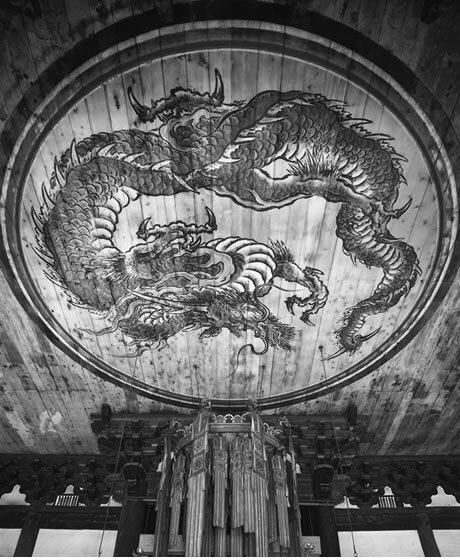
それぞれが躍動感みなぎる龍姿。【水墨画探訪】 Each of them is a dragon with an uplifting.
臨済宗の、大本山寺院の天井や襖には見事な龍が描かれている。禅寺を訪ねる楽しみは、それらの襖絵や天井画をみるのができるからである。
そもそも龍は、仏教を護る八部衆のひとつで、"水をつかさどる神"として中国から伝わってきた架空神仏である。水の神仏として火から家を護る象徴になっている。さらに、中国では、松が龍に例えられ天に昇る意味から繁栄の象徴ともいわれている。だから、お寺の三門や家の門等にも松が植えられているのも、そういう謂れがあるからのようだ。
A beautiful dragon is drawn on the ceiling and fusuma of the Daihonzan temple of the Rinzai sect. One of the pleasures of visiting a Zen temple is to see those fusuma paintings and ceiling paintings.
In the first place, the dragon is one of the eight people who protect Buddhism, and is an imaginary god Buddha that has been passed down from China as a "god who controls water." As a god of water, it has become a symbol of protecting houses from fire. Furthermore, in China, it is said that the pine tree is likened to a dragon and rises to heaven. Therefore, it is because there is such a thing that pine is planted in the temple's three gates and house gates.
とくに、禅寺系の本山では、住職が仏法を大衆に説く法堂(はっとう)の天井に龍が描かれているのが多い。それは法の雨(仏法の教え)を天井から降らすという意味もあるようだ。
In particular, in the main temples of the Zen temple system, dragons are often drawn on the ceiling of the hall where the priest teaches Buddhism to the masses. It also means that it rains the rain of law (the teaching of Buddhist law) from the ceiling.
今回、三寺の龍をご紹介する。建仁寺の天井、襖に描かれている双龍図、そして妙心寺、相国寺の天井の龍。それぞれに個性あふれる龍である。妙心寺は狩野探幽、相国寺は狩野光信など名刹が画き、そして最近では、小泉淳作氏が画いた建仁寺の天井画は円相ではないが、天井全面に双龍が舞っている。双龍図として、過去の名匠に勝るとも劣らない躍動感にあふれている。
This time, I will introduce the dragon of three temples. The ceiling of Kennin-ji Temple, the Ssangyong pictured on the sliding doors, and the dragon on the ceiling of Myoshin-ji Temple and Sogoku-ji Temple. Each is a dragon full of individuality. Myoshin-ji Temple is painted by famous names such as Tanyu Kano, Sokoku-ji Temple by Mitsunobu Kano, and recently, the ceiling picture of Kennin-ji Temple drawn by Junsaku Koizumi is not a circle, but Ssangyong dances on the entire ceiling. As a Ssangyong figure, it is as dynamic as the masters of the past.
また、京都を訪れる機会があれば、ぜひ龍の力感を身近に感じ楽しんでいただければ幸である。
Also, if you have the opportunity to visit Kyoto, I hope you will feel the power of the dragon and enjoy it.
建仁寺双龍図

法堂の天井画「双龍図」は、平成14年(2002)に建仁寺創建800年を記念して、日本画家の小泉淳作氏が約2年の歳月をかけて取り組んだ壮大な作品。互いを絡みあうように「阿吽」の双龍が描かれている。108畳にも及ぶ水墨画の迫力に圧倒される。
Kennin-ji Ssangyong
The ceiling painting "Ssanryuzu" in hall is a magnificent work that Japanese painter Junsaku Koizumi worked on for about two years to commemorate the 800th anniversary of the founding of Kenninji Temple in 2002. The dragon of "Aun" is drawn so as to entangle each other. Overwhelmed by the power of the 108-mat tatami ink painting.
建仁寺襖絵

安土桃山時代に絵師として活躍した海北友松(かいほうゆうしょう)が制作した水墨画群で重要文化財「建仁寺丈障壁画」五十面のうちの礼の間を飾る八面の襖絵。 建仁寺方丈に招かれた客が最初に通される礼の間において、北面には咆哮とともに雲間から出現する龍、そして西面には待ち構えるように睨みをきかす龍。それぞれに雲を従えながら圧倒的な迫力をもって描かれている。
Kennin-ji fusuma
An eight-sided fusuma picture that decorates the courtesy of the fifty faces of the important cultural property "Keni-ji Temple Barrier Painting" with a group of ink paintings created by Yusho Kaiho, who was active as an artist during the Azuchi-Momoyama period. A dragon that appears from the clouds with a roar on the north side, and a dragon on the west side that waits for a glance during the courtesy of the first visitor to Kennin-ji. It is drawn with an overwhelming force while giving clouds to each.
妙心寺天井画

江戸時代初期の絵師・狩野探幽55歳の時の作。製作には実に8年の月日を費やしたといわれている。目が絵全体を囲う円のほぼ中心に描かれている。実はこれが、「目が動く」「表情が変わる」という「八方睨み」と呼ばれ、どの位置から天井を見上げても龍と目が合うようになっている。命を吹き込まれたかのような躍動感が伝わってくる。
Myoshin-ji ceiling painting
Tanyu Kano, a painter from the early Edo period, was created at the age of 55. It is said that it took 8 years for the production. The eyes are drawn almost in the center of the circle that surrounds the whole picture. Actually, this is called "Happo glares", where "eyes move" and "expressions change", and you can see the dragon from any position and look up at the ceiling. You can feel the dynamism of life.
相国寺天井画

慶長10年(1605)に法堂が5回目に再建された際、狩野永徳の長男である狩野光信によって描かれた作品。円相内に描かれた龍は、今も彩色が鮮やかに残っている。現存最古で最大級の法堂建築である堂内で手をたたくと、音が反響し龍が鳴いているように聞こえることから「鳴き龍」と呼ばれている。
Sogoku-ji ceiling painting
A work drawn by Mitsunobu Kano, the eldest son of Eitoku Kano, when the temple was rebuilt for the fifth time in 1605. The dragon drawn in the circle is still vividly colored. When
you clap your hands in the hall, which is the oldest and largest hallway building in existence, it sounds like a dragon is echoing, and it is called a “crying dragon”.
よろしければサポートお願いします。日本の伝統文化に関心を寄せています。若いころに文化圏の異なる地域の方たちとの交流で日本のことをあまりにも知らなかったことに気づかされ、それがきっかけで広く浅く学んでいます。拙いレポートですが、お目に留めていただければ幸です。
